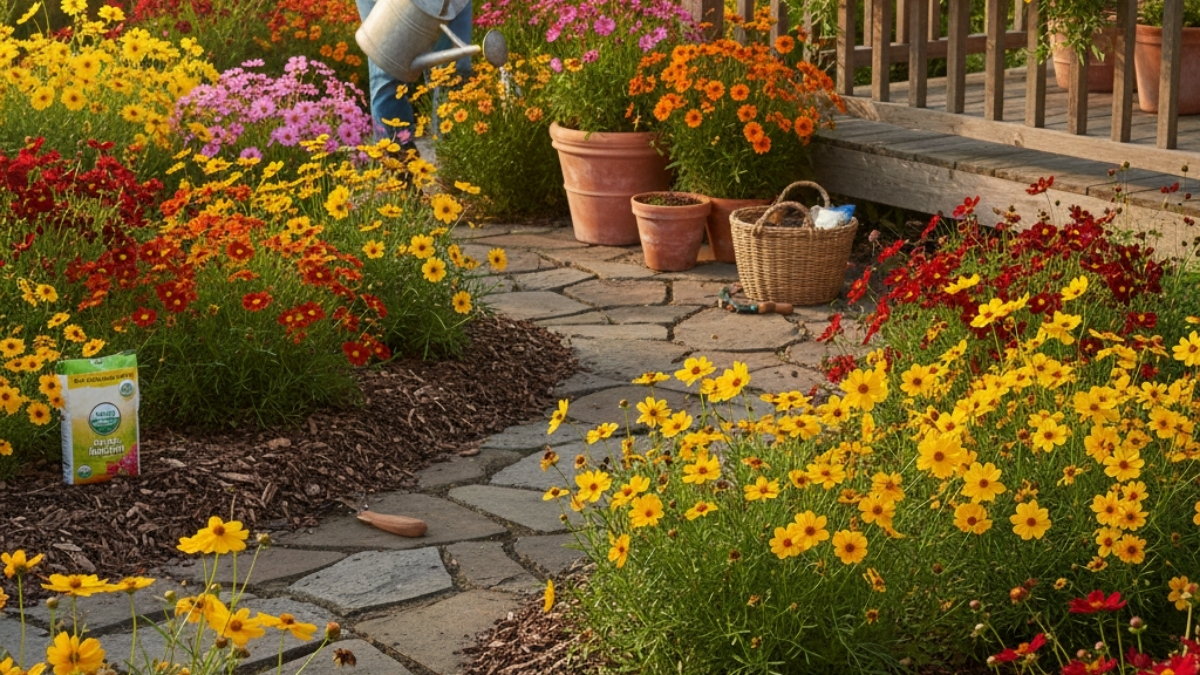Join on WhatsApp
Get the latest updates directly on WhatsApp – motivation, news & more!
Coreopsis, often called tickseed, is a cheerful and low-maintenance flowering plant that brings vibrant color to gardens throughout the growing season. Native to North and South America, it thrives in a variety of climates and soil types, making it a favorite among both beginner and experienced gardeners. With its daisy-like blooms in shades of yellow, pink, red, and orange, coreopsis adds a wildflower charm to borders, containers, and pollinator gardens. Its long blooming period and drought tolerance make it a reliable choice for Indian gardens, especially in regions with hot summers and erratic rainfall.
Choosing the Right Variety
Coreopsis comes in both annual and perennial forms. Annual varieties like Coreopsis tinctoria are fast-growing and ideal for seasonal color, while perennial types such as Coreopsis verticillata and Coreopsis grandiflora return year after year with minimal care. When selecting a variety, consider your local climate, garden space, and desired bloom color. For Indian gardeners, perennial varieties tend to perform better in regions with mild winters, while annuals are perfect for cooler hill stations or short-term displays.
Ideal Growing Conditions
Coreopsis prefers full sun and well-drained soil. It thrives in areas that receive at least six hours of direct sunlight daily. While it tolerates poor soil, it performs best in moderately fertile ground with good drainage. Avoid heavy clay or waterlogged areas, as these can lead to root rot. If your garden soil is compacted, consider amending it with compost or sand before planting. In containers, use a light potting mix with added perlite or cocopeat to ensure proper aeration.
Planting Coreopsis
You can grow coreopsis from seeds, nursery plants, or cuttings. Seeds should be sown directly into the garden after the last frost or during early spring in warmer regions. Scatter the seeds over prepared soil and lightly press them in without covering too deeply. Water gently and keep the area moist until germination, which usually takes 10 to 15 days. For faster results, purchase young plants from a nursery and transplant them into your garden or pots. Space them about 12 to 18 inches apart to allow airflow and prevent overcrowding.
Watering and Fertilizing
Coreopsis is drought-tolerant once established but benefits from regular watering during its initial growth phase. Water deeply once or twice a week, depending on weather conditions, and allow the soil to dry slightly between sessions. Overwatering can lead to fungal issues, so avoid soggy soil. Fertilization should be minimal. Too much nitrogen encourages leafy growth at the expense of flowers. Apply a balanced organic fertilizer or compost once at the beginning of the growing season. Liquid seaweed or vermicompost tea can also be used monthly to boost flowering.
Pruning and Deadheading
To encourage continuous blooming, deadhead spent flowers regularly. This prevents seed formation and redirects energy toward new blooms. Use clean garden scissors to snip off faded flowers just above the next set of leaves. In perennial varieties, cut back the plants by one-third after the first flush of blooms to promote a second wave. At the end of the season, trim the plants to ground level to prepare them for dormancy. In colder regions, add a layer of mulch to protect the roots during winter.
Pest and Disease Management
Coreopsis is generally pest-resistant but may occasionally attract aphids, spider mites, or caterpillars. Inspect the plants weekly and remove pests by hand or spray with neem oil or insecticidal soap. Fungal diseases like powdery mildew or leaf spot can occur in humid conditions. Ensure good air circulation and avoid overhead watering to minimize risk. If symptoms appear, remove affected leaves and treat with a natural fungicide. Companion planting with marigolds or basil can also help deter pests.
Propagation Techniques
Coreopsis can be propagated through seeds, division, or stem cuttings. Collect seeds from mature flowers by allowing them to dry on the plant and then storing them in a cool, dry place. For division, dig up established clumps in early spring or autumn and separate them into smaller sections with healthy roots. Replant immediately in prepared soil. Stem cuttings can be taken during the growing season and rooted in moist potting mix under partial shade. This method is especially useful for preserving hybrid varieties that may not grow true from seed.
Seasonal Care and Maintenance
In India, coreopsis can be grown almost year-round in moderate climates. In northern regions, plant in spring and enjoy blooms until late autumn. In southern and coastal areas, it may flower even during winter. Keep the garden tidy by removing weeds and fallen leaves. Monitor for signs of stress such as yellowing leaves or stunted growth, which may indicate nutrient deficiencies or poor drainage. Rotate planting locations annually to maintain soil health and prevent disease buildup.
Benefits and Uses in the Garden
Coreopsis is more than just a pretty flower. It attracts bees, butterflies, and other beneficial insects, making it a valuable addition to pollinator gardens. Its cut flowers last long in vases and brighten indoor spaces. Some varieties are used in natural dyeing, while others have traditional medicinal uses. In landscape design, coreopsis pairs well with coneflowers, salvias, and ornamental grasses. Its compact growth and vibrant colors make it ideal for edging paths, filling gaps in borders, or adding life to balcony containers.
Conclusion
Growing coreopsis is a rewarding experience for gardeners of all skill levels. With minimal care and maximum impact, this resilient plant offers months of cheerful blooms and ecological benefits. By choosing the right variety, providing suitable conditions, and following simple maintenance practices, you can enjoy a thriving display of coreopsis in your garden year after year. Whether you’re cultivating a wildflower meadow or a tidy urban terrace, coreopsis brings a touch of sunshine wherever it grows.
